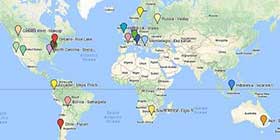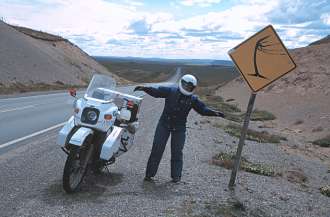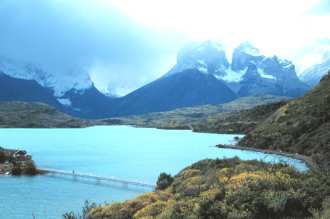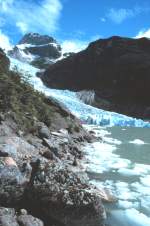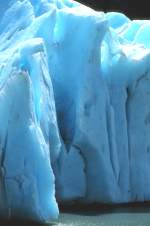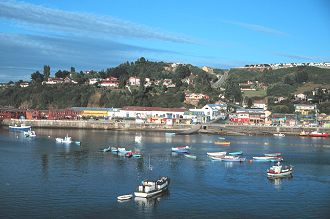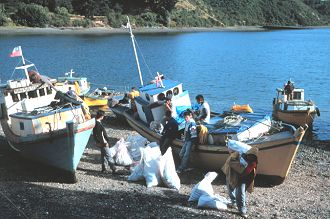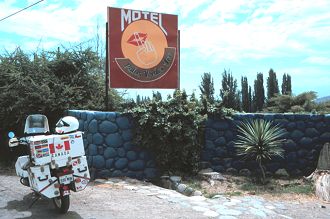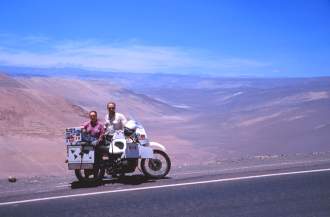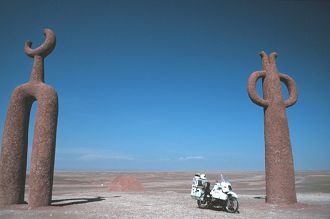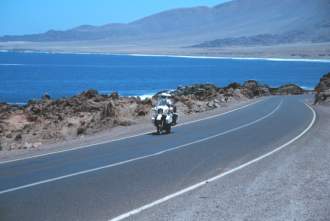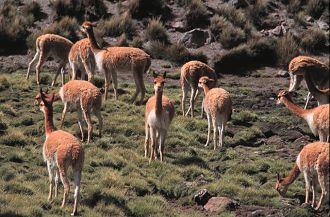Grant and Susan in Chile
20 January, 1998
We had a windy but uneventful drive north from Ushuaia across Tierra del Fuego, then took a 2 hour ferry to Punta Arenas.
Susan and bike beside a sign stating the obvious on the road north in Tierra del Fuego
We spent a couple of days in Punta Arenas trying to get the Web site sorted out, then up to Puerto Natales to catch the ferry to Puerto Montt. During our two days in Puerto Natales, we did a one day trip into the Torres del Paine national park, which was quite spectacular.
Torres del Paine National Park, Chile
On the second day, we took a full day boat trip to the Balmaceda Glacier, which was also very scenic, but we only had about two hours ashore that day before boarding the long ferry, and I am now very happy to be on dry land for the foreseeable future!
Yesterday, after 4 days, we got off the ferry in Puerto Montt. Not exactly in the same class as our Antarctic boat, though. Whew! The Puerto Eden, a boat operated by Navimag in Chile, is a cargo vessel whose operators decided to add passenger capacity about 3 years ago. They just built a square two story block complete with cabins and a cafeteria and then plopped it high above the upper deck, high enough to clear trucks. Also high enough to feel like you're on top of the mast when it starts rockin' and rollin' in rough weather.
However, it is still at heart a cargo boat. Unfortunately the cargo going north with us included about 10 trucks of cows and horses, and by the second day the odor was very noticeable! By the third day when we hit the open ocean stretch and the boat was rolling around pretty good, the combination of motion and the stench of manure was making my stomach very unhappy. They did hose the deck down the day before we landed, but the odor was still very strong. Of course, I was nowhere near as unhappy as the poor horses and cows, who were crammed into the trucks like sardines. The trucks had open tops, so they had lots of air, but they didn't feed or water the cows at all during the voyage. From the passenger lounge you could look out and see the trucks with the horses snapping at each other and the cows just looking miserable, and feel very bad about their treatment. It might have been enough to make some of the passengers turn vegetarian by the end of the trip.
Just as well I wasn't very hungry, as the food (meals were included in the passage price) was pretty mediocre at best. Kind of like your average school cafeteria meals, plain but filling. Some folks thought the food was good, but I guess it depended on where you'd been eating previously. The backpackers don't tend to be as picky as we are! Those of us who had been on the Antarctic trip (there were 3 others on board in that category) persisted in telling other passengers how wonderful the food had been on that trip (including a sous chef to prepare dessert buffets!), which I'm sure didn't endear us to anyone. The best dessert on the Puerto Eden was Jell-O! The other dessert was semolina. Yeccch. Looks and tastes like thick wallpaper paste.
On the bright side, the really bad stretch was only about 12-14 hours, and since I had taken Dramamine pills I didn't get too sick (Grant points out that he didn't feel sick at all the entire voyage) There were lots of activities to occupy your time, mostly movies (English with Spanish subtitles) and National Geographic type videos, mostly in Spanish, of the area, but also tours to the bridge and the engine room, and occasional sightings of whales or dolphins. The scenery was also very pleasant, though more striking for our friend from Arizona than for those of us from British Columbia. On the last night, there was Bingo with lots of prizes, and then a party which went on until 1:30 a.m.
The morning we landed, we had an early breakfast and were off the boat by 8:30, feeling very grateful for dry land and fresh air. A nice surprise, as we pulled out of the parking lot, there was Max, our sunny Italian motorcycle friend waiting for us! He led us to a nice hospedaje here, and over tea we swapped stories. He had opted to drive up instead of taking the boat, and his description of fighting many hours (about 1000 km) of badly corrugated roads interspersed with unexpected and terrifying sandy stretches, and a numbr of crashes, made us feel better about our boat trip. Our description of the cattle boat made him feel better about his choice too, as he really dislikes boats.
Puerto Montt is quite a pretty town of about 110,000 people, and has lots of amenities, including a nice shopping mall and our first Pizza Hut since Cape Town. No prizes for guessing where we had lunch yesterday.
25 Jan/98 - Puerto Montt
Puerto Montt harbour, Chile
We've been here in Puerto Montt for 6 days now, both under the weather with different ailments. We shared a cabin with a couple from Queensland, Australia, who mentioned a couple of days into the trip that they had colds. Grant's symptoms pretty much sound like what they had (sore throat followed by cough), so we figure that's where he caught it. To date I haven't got that one, but I was feeling very queasy the last couple of days on the boat, and it didn't improve much when I got onto land. So I think I might have had a mild case of food poisoning.
Boats on beach in Puerto Montt, Chile
Since a couple of other motorcycle folks we met in Ushuaia are expected on the next boat in on Monday morning, we'll likely hang around and see if they arrive. The place we're staying is only $25 a day including breakfast (no phone or TV in the room, and shared bathrooms, though), and the people are very nice (son muy amable), so we're not feeling rushed to leave. Puerto Montt is a pretty town, and with far and away the best shopping since Buenos Aires, and easier because it's more compact. There's even a reasonable size shopping mall with a food court. So, we're not suffering too badly! The weather here is variable, some amazing downpours, but when it's nice it's gorgeous - not too hot, shirt sleeve weather and bright blue sunshine. Cruel to mention it, with the Ottawans still in the deep freeze.
5 February 1998 - Paine, south of Santiago
We ended up a full two weeks in Puerto Montt, as it took Grant longer to recuperate than me (he's older, after all, and everyone knows males are frailer than females). Our friends never did arrive, so we assume they are still enjoying themselves down in the south of Chile. Max, our sunny Italian motorcyclist, had also not shown again. He left the day after we arrived to go to one of the many hot springs around here, with suitable female companionship. He had run into a couple of the British girls who were in Ushuaia over Christmas, and Ron, who he'd been romancing down south, went with him to the hot springs. Sarah, her friend, had much worse luck - she got bit by a dog the first day in town and had to spend a week in town having rabies shots while her friend went off to the hot springs with a dashing young motorcyclist. Bummer!
Monday morning we headed north, and the weather continued to cooperate. The terrain between Puerto Montt and Temuco is very reminiscent of western B.C. - pine forests interspersed with very lush green pasture land, with snow covered volcanoes in the distance. Lots of logging and wood processing activity here, but also evidence of a lot of reforestation. We did not see really denuded stretches of land, although those might be carefully hidden as B.C. does - leave a swath of trees alongside the road then clear cut behind them. We are much more exposed to the environment on the bike and the fresh piney smelling air was wonderful.
North of Temuco through Chillan and Rancagua the landscape starts to change and becomes more desert like - the hills on both sides of the road are closer but they are scrubby and dry looking. However, it also reminded us of the Okanagan Valley in B.C., as the Chileans are also obviously irrigating the valley. There is heaps of fruit and vegetable production - we saw five Dole plants within about 200 km, as well as Chiquita, UTC and a slew of obviously local food processing plants. These are very big and modern facilities, and there are also numerous roadside fruit and vegetable stands, selling very similar produce to what you would see in Canada in mid summer - tomatoes, watermelons, raspberries, apples, etc. No tropical fruits, so we bought a kilo of raspberries - yum!
We stayed the last night before Santiago in a motel in Paine, (about 40 km out of Santiago), which was obviously designed for discreet romantic assignations.
You drive in, and the shrubbery is such that you don't even see the proprietors. The individual units have gates on the driveway, and if the gate is open then the unit is unoccupied and you can take it. From the room you phone reception and tell them you're there, and they bring you the key and your bill and you pay through a little service door which closes on both sides. The room service menu is extensive, and includes drinks, cigarettes, toothpaste, and 'preservativos' (which does not mean MSG), but refers to items usually made of latex. All these items and food can be delivered by the same mechanism, so you could theoretically do all this without anyone seeing you. The mirrored wall beside the bed is the other clue, but the final evidence is that there's a red paned window from the room into the shower! Nonetheless, the place was nice and clean, and quite reasonably priced, and right next door to a large restaurant complex, so we're not complaining.
This is the second such place we've stayed in since Puerto Montt, (and we've seen lots more along the road) and the basic layout is the same in all of them. The last place we saw them in was San Pedro Sula in Honduras, and we didn't see any motels in Argentina at all, so draw your own conclusions about the Chileno trysting habits. Come to think of it, maybe the Chilenos are on to something - any of you entrepreneurs in other parts of the world seen anything like this?
For us, a motel on the outskirts of town is preferable to a hotel in town, when we're just traveling anyway. They're usually quieter, and we can have the bike right next to the room, which is more secure as well as more convenient for dragging in stuff for the night.
8 February, 1998 - Viña del Mar (northwest of Santiago)
On Thursday, we managed our famous "Johnson Crack of Dawn Start" - we were on the road by noon and had an easy cruise into Santiago. We found a nice hotel near the Republica Metro station, not too close in, with secure parking for the bike, and have spent several days here.
On Friday we spent the afternoon watching Titanic, which is in English with Spanish subtitles, since it's too new to have been dubbed yet. As usual when we hit a big city, we also restocked on items such as contact lens solution which can be hard to find in the smaller towns, as well as more film. We sent our South America rolls back to Canada via DHL - 88 rolls in total, three-quarters of them were Grant's slides, 45 rolls in Antarctica alone! Should be no shortage of pics for the book!
Today we did sightseeing. There are many beautifully restored old buildings in the city centre, including the most attractive post office I've ever seen (not like Canada Post's concrete monstrosities). Santiago's main post office dates from 1882 but looks like it was completed yesterday. We hit the tourist highlights, including the original National Congress building, the Law Courts, the Santiago Cathedral and the Iglesia de San Francisco, parts of which date to 1618, which makes it Santiago's oldest building. Next door is a museum of the colonial era, with some interesting old books and about 60 paintings covering Saint Francis life history.
Those of you who have been to Barcelona would find Santiago very familiar - similar architecture. It is large (4 million approx.), but the Metro makes it easy to get around without a vehicle, and you wouldn't want to drive a vehicle in the centre anyway - the Chilenos drive very fast! We liked it better than Buenos Aires, but that's pretty subjective as we only stayed a couple of days in BA and that included getting the bike out of cargo.
Sunday morning we headed out of town, intending to go west to Valparaiso on the coast. Due to a major navigation failure (the navigator failed to read the map properly), we ended up going north east instead! Oh, well, Grant was relaxed about it. So we drove through Los Andes, then continued on to Portillo, a major Chilean ski resort near the Argentina border. Very nice ride, up a very twisty mountain road (30 switchbacks), but cold enough to need our electric vests on. Afterwards, we drove due west to the ocean and ended up in Viña del Mar, Chile's premier beach resort. One good thing about a skinny country - you can cover a variety of geographies and climates fairly quickly! We never did quite make it to Valparaiso, as the weather was overcast the next morning, and we decided if we couldn't take pictures it wasn't worth hanging around for.
10 February, 1998 - La Caldera
Monday we finally got on our way north - 2,050 km to the border with Peru, much of it desert. We were reminded fairly quickly about the rules of travel in the desert. Rule Number 1 - never pass up a gas station (or a toilet, for that matter), as you never know how far it will be to the next one!
The Atacama Desert
We coasted to a stop by the side of the road in the southern end of the Atacama Desert, miles from anywhere. What a place to run out of gas! We had started the day with about 300 km on the tank, and planned to fill up in La Serena, an attractive beach resort. Grant kept checking prices as we passed several stations, but by the time he had decided the prices were all similar, we were through La Serena and there were no stations to the north of the city. No problem, we knew there were several towns ahead of us.
The small coastal town of Los Hornos had no gas station, the next town, La Higuera, also had no gas station, and Incahuasi, where we stopped for lunch, also had no gas station. By this time, I was starting to get worried. The terrain had changed rapidly after La Serena, into a barren, almost grassless desert. Also, traffic had thinned out considerably (most folks heading for the beaches at La Serena), and there were now long stretches of road with no inhabitants.
Our absolute maximum distance on a tank, with no wind and optimum speeds, is about 600-650 km. The waitress in the restaurant said there used to be a gas station up the road, but it was closed now, and the nearest one was in Vallenar, which would put us at about 570 km on the tank. And the first 300 km had been in constant passing of long lines of traffic, heavy throttle mode. A bit close for comfort, but no help for it now.
About 60 km out of Vallenar, the engine sputtered and quit. Motorcycles don't have fuel gauges, just a reserve capacity which should be good for about 60-100 km. We had only gone on reserve a short while ago, we couldn't be empty already! Grant took off the tank box and peered into the gas tank with a flashlight. "Plenty of gas in there" he announced. "Don't know why it's not running." Whew! I knew he could fix any mechanical problem, but an empty gas tank is a different matter. He fiddled with gas lines and taps on both sides, and finally announced that the bike should be getting gas. He pressed the starter, and sure enough, it ran! I jumped on and we continued down the road. We actually coasted downhill with the engine off a couple of times, so I knew he was worried, too, but we made it to Vallenar at 570 km on the tank, and before filling it he looked in the tank again with a flashlight and said proudly "No worries, there's still plenty of gas in there! At least an inch and a half! We could have gone over 600 km easy." My shattered nerves!
Sculptures in the Atacama Desert, Chile
11 February 1998 - Taltal
We'd planned to be in Antofogasta tonight, but we're in Taltal instead, a very small coastal town about 25 km off the Panamerican Highway, and about 350 km south of Antofogasta. Even those of you with South America maps will have difficulty finding this place. The bike's muffler chose an inopportune moment to rot through, so tomorrow we will have to get some welding done before proceeding north.
The lovely sound of the ocean surf is almost drowned out by the party going on downstairs at the hotel - we figured Wednesday night would be a quiet night, right? No, the locals are having a costume party that starts at 10:00 p.m. and will likely go on until 3:00 a.m. or later. Oh, well. Still, Entel, our favorite telephone company is here (the one which doesn't require our computer to consult the operator before dialing!), so I'll be able to get mail and upload this while Grant works on the muffler.
18 February 1998 - Arica, Chile (just south of Peru)
We're almost at the end of Chile now, having covered over 3,500 km since leaving Puerto Montt on 2 February. A skinny but very longggg country. Highly recommended for driving, with superb and varied scenery. Much more interesting than Ruta 3 in Argentina! We even enjoyed the Atacama Desert, except for the heat.
It's a small world after all. We wanted to catch up to Max (our Italian friend) as I had a number of messages to give him (young ladies of varying nationalities had left notes for him in Puerto Montt). After missing him in Santiago by a couple of hours, we ran into him again in Antofagasta completely by accident, outside a currency exchange shop. He had spent almost 2 weeks lazing around at his friends' house near Santiago (they had a swimming pool), so that's why we caught up to him. Anyway, he and Grant worked on the bikes all day Saturday, and most of Sunday. Max is a bit new at motorcycles, so Grant is helping him with the maintenance stuff.
We had a nice ride up the coast on Monday, and some fantastic scenery. The desert runs right down to the coast in the north, and the contrasts are very spectacular. The fauna du jour were various species of seabirds, especially pelicans, which are numerous. Fun to watch them dive straight down after the fish, then float on the water looking quite pleased with themselves if they catch one.
Max had planned to go inland from Antofagasta, but decided to accompany us via the coast road to Iquique instead, as he hoped to find a replacement motorcycle tyre at the Zofri (duty free zone) there. His front tyre was pretty bald, and he certainly cannot make it to the US on it. (He should have replaced it in Santiago, but balked at the $300 cost there from the local BMW dealer). We arrived in Iquique around 7:00 p.m., and headed immediately for the Zofri to try for Max's tyre. We also needed a replacement for our spare tube, as ours had melted in its storage space near the muffler. No problem for the tube, but mucho problema for Max. While I waited with the bikes, they got shunted from shop to shop for over an hour in a fruitless search for the right sized tyre. Meanwhile the sun was setting and we still had not found a place to sleep for the night, which always makes me nervous.
Finally we headed back into town and began the search for accommodation. It's usually a straightforward process, as I hop off the bike and check out the room and parking arrangement while Grant waits. This time it was more complicated, as Max's budget only allows for the low-end residenciales / hotels, some of which are truly grim. To add to the problem many of the better low-end hotels were already full by this time. Trying to find a location for both of us proved impossible and frustrating, and finally around 10:00 p.m. we left Max in a fleapit hotel and found ourselves a nicer one (clean sheets, hot water, luxuries like that).
Tuesday we continued up to Arica, through amazing desert hills (almost mountain size) and valleys. In Arica Max got incredibly lucky. A Carabinero (Chile's national police force) on motorcycle spotted him outside a hotel, and after a brief conversation, led him and us to a motorcycle shop which had a tyre to fit Max's bike. Hoorah! If he hadn't found it here, he would have had to arrange to have one sent by courier from Miami to La Paz, which means it would likely have cost as much as if he'd bought it in Santiago, and a lot more aggravation. The experience reinforced one of our cardinal rules of travel - if you find something you need, DO NOT assume that it will be cheaper (or even available) down the road. Buy it!
Today (Wednesday) Max and Grant are putting on the new tyre and continuing a complicated process of adjusting Max's front wheel which they started in Antofagasta and which has consumed a couple of days now. Tomorrow we head east about 160 km to a national park which has thousands of vicunas. Afterwards, we return to Arica and north to Peru, and Max heads across into Bolivia. The road east to Bolivia is paved only to the Chile border, and afterwards it is a very bad road. From the South American Handbook section on Bolivia: "From Patacamaya, the 'road', which climbs to altitudes of around 5000 meters, and which is, unmarked except for the tracks of heavy lorries, becomes dirt, sand, stones, mud and water. Allow 6-8 hours to cover the next 220 km to Tambo Quemado. Four wheel drive obligatory....Watch out for river crossings and seek advice before traveling during or just after rainy season (Dec-Apr)." But this is the shortest and main truck route to the coast from La Paz, and Max is optimistic. Must be the Italian heritage.
Vicunas, Chilean Andes, en route to Bolivia, at about 3,500m. altitude
21 February, 1998 - Arica, Chile
We're in Arica again today, leaving for Peru this morning. We drove almost to Bolivia yesterday through the Parque Nacional Lauca, saw lots of vicuñas, and got to a very high altitude (4,580 meters) before turning back to the coast. All of us had some symptoms of soroche from the altitude - mostly headache and low energy, though Max also had some dizziness on Thursday. The bike was suffering more from lack of oxygen than we were - the poor thing sounded pathetic even after tinkering by Grant. (smaller main and pilot jets.)
We parted company - once again - with Max, who was heading on to La Paz (something about meeting a girl...) We almost went with him, but though the road to La Paz turns out to be paved, getting back to the Panamerican Highway via Lake Titicaca and Puno to Arequipa sounded like a major effort on very bad roads. We were also feeling less than great due to the altitude. Finally, the weather to the east looked dreadful, it was already raining and cold (electric vests on high and rain jackets for warmth!) at Chungara near the border, so picture taking opportunities were not likely. So we asked the question: "Does this sound like fun?" and decided to head back west. Max is convinced we're wusses, I'm sure, but he has lots of time and is much better off on bad roads than we are two-up. A few days resting and acclimatising at altitude would help a lot, and plan on only 100- 200 km a day on the bad roads, but we don't have time to spare anymore, as we need to be back in Victoria for mid March. And we still have Peru, Ecuador and Colombia to do!
Member login
Announcements
Thinking about traveling? Not sure about the whole thing? Watch the HU Achievable Dream Video Trailers and then get ALL the information you need to get inspired and learn how to travel anywhere in the world!
Have YOU ever wondered who has ridden around the world? We did too - and now here's the list of Circumnavigators!
Check it out now, and add your information if we didn't find you.
Are you an Overland Adventure Traveller?
Does the smell of spices wafting through the air make you think of Zanzibar, a cacophony of honking horns is Cairo, or a swirl of brilliantly patterned clothing Guatemala? Then this is the site for you!
Hosted by Grant and Susan Johnson, RTW 1987-1998
Johnson's Home
Who Are We?
The BIKE Story
Press Stories about us
Our "Rules of the Road"
Photo Album 500+ images
"Quick" highlights -
Top 31 photos
Mexico
Central America
New Zealand
Australia
Europe
England
Isle
of Man
Norway
Sweden
Denmark
Germany
Netherlands
Spain
Gibraltar
Africa
Tunisia
Libya
Egypt
Kenya
Tanzania
Malawi
Zimbabwe
Botswana
Namibia
Caprivi Strip
Etosha
Sossusvlei
South
Africa
South America
Argentina
Tierra del Fuego
Chile
Peru
Ecuador
Colombia
Next HU Events

Be sure to join us for this huge milestone!
ALL Dates subject to change.
2025 Confirmed Events:
Virginia: April 24-27
Queensland is back! May 2-5
Germany Summer: May 29-June 1
Ecuador June 13-15
Bulgaria Mini: June 27-29
CanWest: July 10-13
Switzerland: Aug 14-17
Romania: Aug 22-24
Austria: Sept. 11-14
California: September 18-21
France: September 19-21
New York: October 9-12 ![]()
Germany Autumn: Oct 30-Nov 2
2026 Confirmed Dates:
(get your holidays booked!)
Virginia: April 23-26
Queensland: May 1-4
CanWest: July 9-12
Add yourself to the Updates List for each event!
Questions about an event? Ask here
Books

All the best travel books and videos listed and often reviewed on HU's famous Books page. Check it out and get great travel books from all over the world.
NOTE: As an Amazon Affiliate we earn from qualifying purchases - thanks for your help supporting HU when you start from an HU Amazon link!





